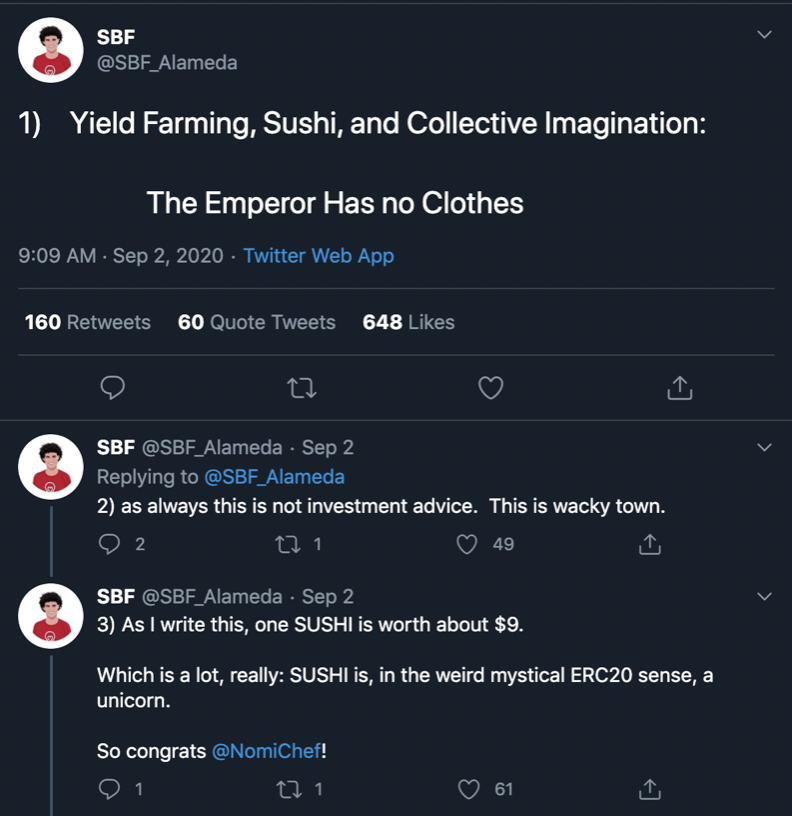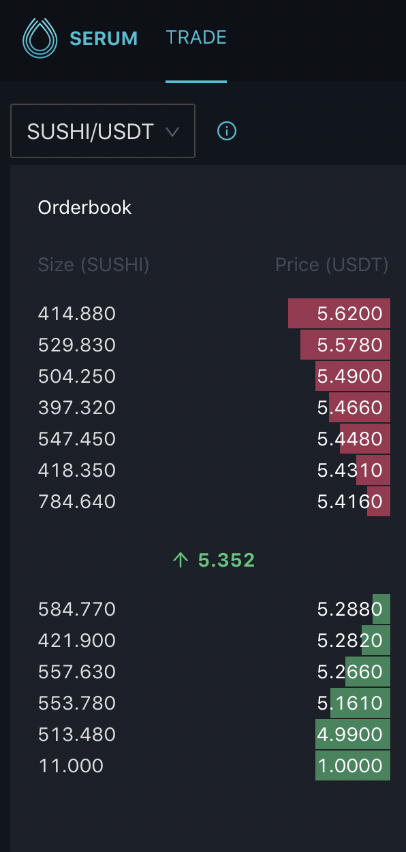——Translated from Twitter by FTX CEO Sam Bankman-Fried@SBF_Alameda
As always, this does not constitute investment advice. It's a weird world. At the time of writing, the price of a SUSHI token is already $9. This is really expensive: SUSHI is a strange and mysterious ERC20 protocol, a unicorn, congratulations Nomi Chef@NomiChef!

I know most people will say after reading my tweets and the price of SUSHI tokens"Oh, the price of SUSHI will definitely drop in the future. It's actually possible that as I continue to write, SUSUI is probably past its peak and the price "falls back" to $8. I don't think many people have discovered this though.
Let’s take a step back and delve deeper into what exactly is liquidity mining? The purest form of liquidity mining is:
For example, there is a Y token, and you put this Y token together with USDC in Uniswap's fund pool (Uniswap pool). Then you will get 1 Y token as a reward every day, that is to say, the airdrop reward of 1 Y token is 1 Y token, so the supply of Y token doubles every day.
If all I do is mint new tokens, and every day I mint more new tokens and airdrop them to token holders, probably not too many people will care. Because anyone can mint new ERC20 tokens at will. But the key here is the pool of funds. rather than liquidity.
Many believe that the key to the success of these mining projects is the liquidity provided to them by automated market makers (AMMs). While AMMs are helpful, I don't think that's the point. In fact, the help of AMM to these liquid mining projects is far more than that
price"price". This price will not change if the mining participants are lazy.
This is where things get weird. If you put the proceeds of Y tokens into the same fund pool, the proportion of assets in the fund pool will be changed, so the price of Y tokens will fall, so that the overall market value will not change. However, if you invest the proceeds of Y tokens in other places, the original fund pool will not know that there are actually more Y tokens out there.
So when you are over-inflating the supply of Y tokens, if no one intervenes to adjust the price, the price of Y tokens in the AMM will remain unchanged, but its market value will be hyperinflated. At this point you might ask, who cares about this? People will always be able to change the price of the token! But because of this, at a certain point in time, at a certain magical moment, Y expanded into a token with a unicorn market value.
create"create"income.
Although all this seems absurd! There are exceptions though. Why is BTC the most valuable cryptocurrency? Why not BCH, ETH or DOT? Is it because of its unique design? may be. But the real reason why the market value of BTC is 220 billion US dollars is simply because the price of each BTC is 12,000 US dollars. And the reason why it is 12,000 US dollars each is precisely because the market is fair at this price.
What I mean is that BTC already has certain market advantages: it is supported by many APPs, and it is favored by institutional investors, etc. However, if one day, when we wake up and think that each BTC is only worth $1,000, the exchange will also clear all BTC order books...
…by that time, the buy price of BTC may be around $900, and the sell price may be around $1100. In that case, BTC would be worth $1,000. Perhaps at this time the market thinks that BCH or XTZ should replace BTC. All in all, our consensus determines the price of a crypto asset.
It's straightforward. Taking BTC as an example, you will use the longest valid chain as the correct chain. If you are a miner, you will mine on this chain and calculate new blocks. But if one day, all the miners wake up and decide: the last 100 blocks we mined are too boring, so let's start mining from the block before these 100 blocks!
Like the price of encrypted assets, the blockchain is also determined by market consensus.
Like many other things in life, some things have immediate physical value. But to some extent, to some very large extent, everything is worth as much as we or the market thinks about it. The most valuable things in the world have their value born and sustained by our collective imagination.
Back to the topic of liquidity mining, a bunch of Y tokens are always falling from the sky, so what should the value of Y be? Assume that the original market price of Y token is $1. Then there were so many airdrops, so the total amount doubled again. How much should each Y pass be worth at this time? If you just look at the AMM price, it looks like the Y token is still $1.
should"should"It needs to be pulled back to $0.5. However, the Y-token before the circulation doubled is not necessarily more valuable than the current Y-token, and in fact, the current price cannot be completely limited based on the previous price.
Well, looks like hyperinflation, but so be it. When I look at that pool, it tells me the Y token is $1, and even Coincecko says it's $1! Then it's $1! The market value of the Y pass should also double, and the income will also increase crazily.
Therefore, the ultimate purpose of creating Y tokens is actually to induce people’s collective imagination of the price and convince the market that the price of Y tokens is still worth $1 each even after the number doubles. It does, and we believe so, so it's the price. Although we are all rich on the surface, this wealth is created out of thin air and has no real basis. It is impossible for us to sell these assets without driving down the price significantly.
However, we can continue to hold these assets. As long as everyone is determined to hold these tokens, everyone can continue to be rich on the surface. However, even so, the real assets in this world will not really become more and more. It is because these people who firmly believe that the Y token is worth 1 dollar but do not have 1 dollar have helped the world create this wealth out of thin air.
In fact, the economic model of Y Token also makes us understand that some of our deep-rooted values may actually not stand the test. Because when you try to question them, you'll find that they simply don't hold water.
Anyway, a few days ago, a chef cooked a liquid mining full meal for us, and at the same time taught us a valuable lesson and let us know ourselves better.
First, he taught us that if we believe that a token is worth $1 billion, then it is possible that it will be worth $1 billion, at least temporarily. He also taught us that encrypted assets can be divided into two types, one is named after "food", and the other is "blue chip" projects with real long-term investment value.
Those "named after food" projects only have speculative value, and only the other part of "blue chip stocks" have real long-term value. Maybe sometimes it's just our consensus that checks whether these projects are good or bad. When high returns appeared, our consensus was shaken, and we lost ourselves in different high-yield fund pools...
...will only find out who was swimming naked when the tide goes out
If today is really the last day for the chef to present us with a sumptuous mining feast, please make it your last supper:
If not, may he continue to use his excellent cooking skills to take us on a journey in the ocean of "food".






